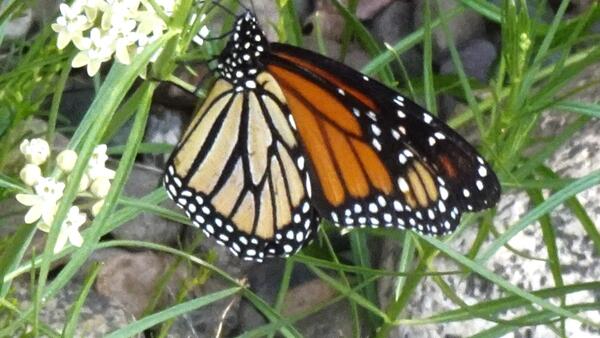Pulling Weeds, Pondering Ecosystems: Lessons from Northern Arizona
"I do some of my best thinking while pulling weeds." — Martha Smith
By DR. CAMERON BARROWS
Lately I have been doing a lot of thinking about weeds. The rich volcanic soils here in northern Arizona are especially good at nurturing weeds.
Like our home in the Coachella Valley, our home here at 7,000-feet elevation is landscaped using local native trees, shrubs, and annual wildflowers. Broad-tailed hummingbirds visit our Arizona penstemons and fuchsias, and mountain chickadees, Stellar’s jays, and hairy woodpeckers visit our aspens every day. Human visitors often notice and admire the rich diversity of native shrubs, trees and annual flowers that we have collected in our yard. But I see the weeds. By weeds I refer to plants not native to this region, plants that arrived here by piggy-backing on human transport from other continents, but especially I refer to those plants that do nothing to nurture the birds, butterflies, moths, and bees. Every day I pull weeds and every day new weeds (or perhaps the same ones I pulled yesterday) sprout and resprout.
Pulling weeds gives me plenty of time to think. The native plants are coddled for their first few months. I make sure they get just the right amount of water, and the right amount of sun, and make sure that the weeds are kept at bay. Weeds thrive with abuse. Cheat grass, Bromus tectorum, is native to Europe’s Mediterranean region. It was brought here to “enhance” the winter-spring forage for range cattle across western North America. Called cheat grass because it sprouts after the first winter rains and then grows vigorously, forming dense stands, “cheating” the native annuals of any hope they had of sharing that precious rainwater. Then the cheat grass dies, but stays rooted, perfect tinder for carrying wildfires across the desert and forest landscapes. Recent desert wildfires are very often fueled by cheatgrass. Desert plants have no evolutionary history with fire, and so lack any adaptation for surviving fires. When we arrive here in early summer our yard is covered in cheat grass and our first job is pulling it out and bagging it before its seeds disperse. A good plan, but with every tug, seeds shower from the grass stalks, laughing at us with their promise that they will be back next year.
If you travel to the Mediterranean region and search for cheat grass, you might find it with a lot of searching, and even then, it grows as isolated plants here and there, not the monotypic “seas” of grass we see here in the arid southwest. The difference is that in their native land, the soil is not as fertile as ours, and there are other organisms, primarily fungi, that keep the cheat grass from sprouting and producing viable seeds. So, I need to amend my weed-definition to include non-native species which have arrived without the associated organisms that keep their populations in check in their homelands. Should we then import those fungi to control cheat grass? I think of the children’s nursery rhyme about the “poor old lady who swallowed the fly, who then swallowed a spider to catch the fly, she swallowed the spider that went zip down inside her. Then she swallowed a bird to catch the spider…” and so on and so on. The point is that introducing a new fungi or pathogen to control a weed could have unintended consequences to our native species, and so we must tread very carefully with any proposal to introduce something new to control weeds.
Another weed I spend my hours here pulling is called “bind weed.” It is a morning glory with a white flower, but that’s where my appreciation stops. It is a vine that chokes and strangles the native plants (hence the common name). Controlling bind weed is much like playing “whack-a-mole,” pull it out here and it shows up there. Pull it there and it re-appears where you started. It has an extensive root system that seems to cover tens of meters in area. Pull the above-ground plant and the roots sprout elsewhere. Dig out the roots and if any piece is left behind, it sprouts again. Dig all the roots out and it will sneak in from our neighbors’ yards. I have an unrealistic belief that eventually I will win, that all the bind weeds will eventually be gone.
While I pull weeds, I think about native ecosystems, native communities, where dozens, perhaps hundreds of species live together. Each species has its own niche, and together there is a balance, an unconscious but effective exchange and sharing of resources that allows for rich biodiversity. Sure, native species can compete for food and space, but over time there is a balance. I still am amazed at the richness of our desert. On any trail we might see three to seven or eight species of lizards. Most are insectivores, but there are apparently enough insects for all and for still sustaining a healthy insect population. Why doesn’t one lizard species eat all the insects, causing the other lizards to perish? They don’t, perhaps there are additional forces keeping the lizard populations in check, from overpopulating and pushing out the other lizards. Something else to ponder while I am pulling weeds. Another definition: weeds take on a more aggressive, pejorative role at the expense of the native species. Unchecked and biodiversity is reduced. To me that is the most important definition. Weeds don’t just add to the number of species living in a region, they put other, native species at risk of extinction. Under this definition, a species arriving from elsewhere is only a weed when its arrival erodes native biodiversity.
Nullius in verba – Go outside, tip your hat to a chuckwalla (and a cactus), and think like a mountain
